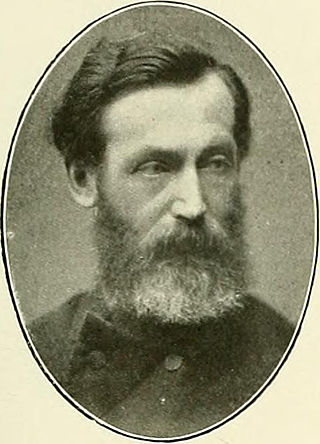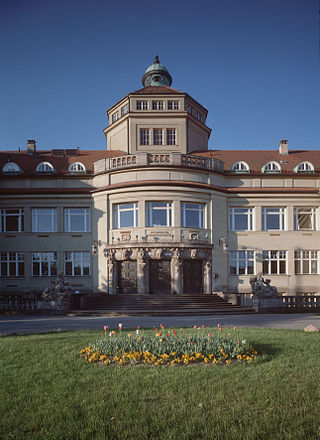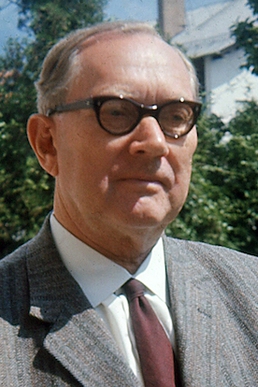Related Research Articles

Lichenology is the branch of mycology that studies the lichens, symbiotic organisms made up of an intimate symbiotic association of a microscopic alga with a filamentous fungus. Lichens are chiefly characterized by this symbiosis.

Ferdinand Christian Gustav Arnold was a German lichenologist and taxonomist born in Ansbach, Bavaria. Even as a high school student he showed an active interest in botany: "Ich und August Gattinger ... durchstreiften von November 1846 bis zum Spätherbst 1847, Pflanzen sammelnd, die Landschaft von München nach allen Richtungen.".

The Botanische Staatssammlung München is a notable herbarium and scientific center maintained by the Staatliche Naturwissenschaftliche Sammlungen Bayerns. Its building is located within the Botanischer Garten München-Nymphenburg area at Menzinger Straße 67, München, Bavaria, Germany. A center for data science and biodiversity informatics called SNSB IT Center is affiliated. Its library is open to the public; scientific collections are open to researchers by appointment.
Aino Marjatta Henssen, was a German lichenologist and systematist. Her father, Gottfried Henssen, was a folklorist and her mother was Finnish.

Henry Robert Nicollon des Abbayes was a French botanist and lichenologist. He was the chair of the Botanical Department of the University of Rennes and an expert on the flora of Great Britain. The standard author abbreviation Abbayes is used to indicate this person as the author when citing a botanical name. H.R.N. des Abbayes was editor of four exsiccata series distributing lichen reference specimens among herbaria.

Heinrich Gustav Flörke was a German botanist and lichenologist. The standard author abbreviation Flörke is used to indicate this person as the author when citing a botanical name.

Ernst Stizenberger was a German physician and lichenologist.

William Louis "Bill" Culberson was an American lichenologist.
George Knox Merrill was an American lichenologist. He was a leading exponent of lichenology in the early 20th century. He was particularly interested in species of the family Cladoniaceae, in which he published several new species, varieties, and forms. In 1909 he started publishing Lichenes Exsiccati, which he continued intermittently until 1927; 400 specimens were presented in two exsiccata series.
Josef Hafellner is an Austrian mycologist and lichenologist. He was awarded the Acharius Medal in 2016 for his lifetime contributions to lichenology. Before his retirement, he was a professor at the Karl-Franzens-Universität in Graz. Hafellner started developing an interest in lichens while he was a student at this institution, studying under Josef Poelt. He earned a master's degree in 1975 and a PhD in 1978, defending a doctoral thesis about the genus Karschia. In 2003, Hafellner received his habilitation. By this time, he had studied with French lichenologist André Bellemère (1927–2014) at Saint-Cloud, where he learned techniques of transmission electron microscopy and how their application in studying asci could be used in lichen systematics. His 1984 work Studien in Richtung einer natürlicheren Gliederung der Sammelfamilien Lecanoraceae und Lecideaceae has been described as "probably the single most influential publication in lichen systematics in the latter half of the 20th century".
Rolf Santesson (1916–2013) was a Swedish lichenologist and university lecturer. He was awarded the Acharius Medal in 1992 for his lifetime contributions to lichenology.
Thomas Hawkes Nash III is an American lichenologist. His research is about the biology and ecology of lichens, and the effects of air pollution on plants and lichens. He is known as an authority on the family Parmeliaceae. During his long career at the Arizona State University, he helped develop the lichen herbarium into a world-class collection with over 100,000 specimens representing more than 5000 species. In 2010, the year of his retirement, he was awarded the Acharius Medal for lifetime achievements in lichenology, and the following year had a Festschrift published in his honor.
Helge Thorsten Lumbsch is a German-born lichenologist living in the United States. His research interests include the phylogeny, taxonomy, and phylogeography of lichen-forming fungi; lichen diversity; lichen chemistry and chemotaxonomy. He is the Associate Curator and Head of Cryptogams and Chair of the Department of Botany at the Field Museum of Natural History.
Antonín (Toni) Vězda was a Czech lichenologist. After completing a university education that was postponed by World War II, Vězda taught botany at the Czech University of Life Sciences. In 1958, he was dismissed from his university position as a result of the restrictions placed on academic freedoms by the communist regime in power. He eventually was hired as a lichen researcher by the Czechoslovak Academy of Sciences, who allowed him to work from his apartment, which served also as an office and herbarium.

Gunnar Bror Fritiof Degelius was a Swedish lichenologist. Between the publications of his first and final scientific papers, Degelius had a 70-year-long research career. While he was best known for his expertise on the lichen genus Collema, he also wrote important papers on lichen biology and ecology, floristic studies of the Nordic countries and various other areas around the world, and lichen succession. Degelius described 124 new taxa, and published about 130 scientific papers. In 1992 he was one of the first to be awarded the Acharius Medal for his lifetime contributions to lichenology. Fifteen species and three genera have been named in honour of Degelius.

Johan Petter Norrlin was a Finnish botanist and a professor of botany at the University of Helsinki from 1879 to 1903. He was a pioneer of plant geography in Finland, and is also well known for his work on lichens and on the taxonomy of the apomictic taxa of the plant genera Hieracium and Pilosella.
Josef Anders was a Czech botanist and lichenologist.

Exsiccata is a work with "published, uniform, numbered set[s] of preserved specimens distributed with printed labels". Typically, exsiccatae refer to numbered collections of dried herbarium specimens or preserved biological samples published in several duplicate sets with a common theme or title, such as Lichenes Helvetici. Exsiccatae are regarded as scientific contributions of the editor(s) with characteristics from the library world and features from the herbarium world. Exsiccatae works represent a special method of scholarly communication. The text in the printed matters/published booklets is basically a list of labels (schedae) with information on each single numbered exsiccatal unit. Extensions of the concept occur.
Hannes Hertel is a German botanist and taxonomist and was Director of the State Herbarium in Munich, Germany 1992–2004. His specialist areas are the fungi and lichens.
Guido Benno Feige was a German lichenologist and botanist known for his contributions to lichen secondary chemistry, taxonomy, and floristics. He was a highly regarded educator and researcher, with a legacy that includes the foundation of a botanical garden and a lichen herbarium. In honour of his academic excellence and contributions to the field of lichenology, a new genus and two species were named after him.
References
- 1 2 3 4 "Acharius Medallists Josef Poelt". International Association for Lichenology. Archived from the original on 2007-03-11. Retrieved 2022-10-05.
- ↑ Mayerhofer, Helmut; Hafellner, Josef; Scheuer, Christian (1996). "Josef POELT (1924-1995)" (PDF). Naturwissenschaftlicher Verein für Steiermark. 126: 11–15.
- 1 2 3 4 5 6 7 8 9 10 11 Hertel, H; Nimis, PL; Vezda, A (1996). "A tribute to Josef Poelt (1925 - 1995)". The Lichenologist. 28 (2): 183–187. doi:10.1006/lich.1996.0016. S2CID 84249983.
- 1 2 3 4 5 "Poelt, Josef (1924-1995)". Global Plants. JSTOR. Retrieved 5 October 2022.
- ↑ Triebel, D. & Scholz, P. 2001–2024 IndExs – Index of Exsiccatae. – Botanische Staatssammlung München: http://indexs.botanischestaatssammlung.de. – München, Germany.
- ↑ Hawksworth, D L (1982). "Bestimmungsschlüssel europäischer Flechten. Ergänzungsheft II. By J. Poelt and A. Věczda. [Bibliotheca Lichenologica no. 26.]". The Lichenologist. 14 (1): 102–103. doi:10.1017/S0024282982000218. S2CID 84953107 . Retrieved 5 October 2022.
- ↑ "Acharius Medallists". International Association for Lichenology. Retrieved 21 September 2022.